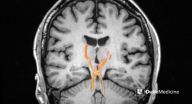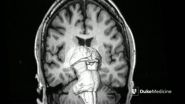(Press-News.org) DURHAM, N.C. - Scientists at Duke Medicine have produced a 3-D map of the human brain stem at an unprecedented level of detail using MRI technology.
In a study to be published June 3 in Human Brain Mapping, the researchers unveil an ultra high-resolution brain stem model that could better guide brain surgeons treating conditions such as tremors and Parkinson's disease with deep brain stimulation (DBS).
The new 3-D model could eliminate risky trial-and-error as surgeons implant electrodes -- a change akin to trading an outdated paper road atlas for a real-time GPS.
"On the conventional MRI that we take before surgery, the thalamus looks like a gray mass where you can see only the borders," said neurosurgeon Nandan Lad, M.D., Ph.D., director of the Duke NeuroOutcomes Center and an author of the paper. "Now we will have actual detail. With this map, for the first time we're able to see the thalamus and that underlying circuitry that we are modulating."
Many neurosurgeons currently rely on lower resolution CT and MRI scans and geographic coordinates relative to the planes of the brain to guide them when placing electrodes into the thalamus. They are targeting a circuit called the dentatorubrothalamic tract or DRT (depicted as an X-shaped pathway in the accompanying image), Lad said.
Surgeons must often remove and reinsert electrodes and test frequencies to find the spots inside the thalamus where, for instance, the electric current subdues the hands of a patient with debilitating tremors. This indirect targeting is the standard of care for DBS, but comes with risk. Moving an electrode requires another pass through delicate tissue, and complications from DBS can include hemorrhage, seizure, or memory problems.
"This map will potentially help us reach the optimal target the first time," Lad said. "It could eliminate trial and error and make the surgery safer."
The map was produced from a 10-day scan of a healthy donor's postmortem brain stem in a 7-Tesla MRI system, and then converted into a 3-D model that can be proportionally scaled to fit a person's unique brain anatomy using a high-performance computing cluster.
"These images are 1,000 times more detailed than a clinical MRI," said G. Allan Johnson, senior author of the paper and director of the Duke Center for In Vivo Microscopy where the brain stem was scanned. "You can actually see the nerve fibers in the brain, how they're crossing, and the subtleties of contrast between gray and white matter in the brain far beyond what a clinical scan could offer."
To test the accuracy of the model, the researchers conducted a retrospective study of 12 patients who had already been treated successfully for tremors using DBS. The researchers used the 3-D model to predict the best placement for the electrodes in each patient. The predictive computer model and the actual successful electrode placements correlated for 22 of 24 electrodes in the dozen patients, the study showed.
The researchers will soon begin a prospective study using the 3-D model to guide DBS surgery.
"As time goes on, imaging will only continue to get better," Lad said. "We are well-equipped and at the cutting edge of understanding how to apply this technology, and will be in an even better position to treat more patients with fewer side effects."
The Duke team will also pursue high resolution imaging of other circuits in the brain, brain stem and spinal cord to develop new treatments for other conditions.
"We now have a guide to be able to visualize these complex neuronal connections that would otherwise be impossible to see," said Evan Calabrese, Ph.D., the lead author of the paper who engineered the 3-D model. "This will help us continue to explore applications for treatments of Alzheimer's disease, neuropathic pain, depression and even obsessive compulsive disorders."
INFORMATION:
In addition to Johnson, Calabrese, and Lad, study authors include Patrick Hickey, Christine Hulette, Jingxian Zhang, and Beth Parente.
The researchers received funding from the National Institutes of Health and the National Institute of Biomedical Imaging and Bioengineering (P41 EB015897).
An international team of scientists led by Cardiff University researchers has provided the strongest evidence yet of what causes schizophrenia - a condition that affects around 1% of the global population.
Published today (17:00BST, 03/06/2015) in the journal Neuron, their work presents strong evidence that disruption of a delicate chemical balance in the brain is heavily implicated in the disorder.
In the largest ever study of its kind, the team found that disease-linked mutations disrupt specific sets of genes contributing to excitatory and inhibitory signalling, ...
A large majority of Americans--including gun owners--continue to support stronger policies to prevent gun violence than are present in current federal and most state law, according to a new national public opinion survey conducted by researchers with the Johns Hopkins Center for Gun Policy and Research at the Bloomberg School of Public Health.
The survey is a follow-up to one conducted by the same researchers in early 2013, shortly after the shooting at the Sandy Hook Elementary School in Newtown, Connecticut that left 26 dead.
The results are published online in Preventive ...
This news release is available in French. Professors Frederick Gosselin and Daniel Therriault, along with their master's student Renaud Passieux, are not related to Spiderman. Nevertheless, these Polytechnique Montreal researchers have produced an ultra-tough polymer fibre directly inspired by spider silk! They recently published an article about the project in the journal Advanced Materials.
Spider silk: a thread with stunning properties
Three to eight microns in diameter but five to ten times tougher than steel or Kevlar: despite its lightness, spider silk has ...
Love the opera? Hungry for hip hop? It turns out that your musical likes and dislikes may say more about you than you think, according to UBC research.
Even in 2015, social class continues to inform our cultural attitudes and the way we listen to music, according to the study, which was recently published in the Canadian Review of Sociology.
"Breadth of taste is not linked to class. But class filters into specific likes and dislikes," said Gerry Veenstra, study author and professor at UBC's Department of Sociology.
The study involved nearly 1,600 telephone interviews ...
A NASA-generated animation of NOAA's GOES-West satellite imagery from June 1 to 3 showed Hurricane Andres' eye disappear as the storm weakened into a tropical storm.
NOAA's GOES-West satellite has provided continuous visible and infrared imagery of the former hurricane since it was born. An animation created by the NASA/NOAA GOES Project at NASA's Goddard Space Flight Center in Greenbelt, Maryland captured the storm as it made the transition from a hurricane, back into a tropical storm. Andres is located in the Eastern Pacific Ocean, south of Baja California, Mexico. ...
Alcohol use disorder as defined by a new diagnostic classification was widespread and often untreated in the United States, with a lifetime prevalence of 29.1 percent but only 19.8 percent of adults were ever treated, according to an article published online by JAMA Psychiatry.
Alcohol use disorders are among the most prevalent mental health disorders worldwide, resulting in disability and contributing to illness and death. Because of the seriousness of alcohol use disorders, updated epidemiologic data are needed given the changes to the alcohol use disorder diagnostic ...
Tropical Storm Blanca strengthened into a hurricane while remaining almost stationary and about 400 miles west of the west coast of Mexico on June 3. NASA's Terra satellite captured an image of Blanca before it strengthened, while NOAA's GOES-West satellite saw the strengthening storm develop a pinhole eye.
Satellite data indicate that Blanca continues to rapidly strengthen as a small eye has become apparent in infrared imagery from NOAA's GOES-West satellite during the early morning hours today, June 3.
Blanca hasn't moved much in the last day but has continued to ...
When the scent of a fragrant product triggers a fond memory that a customer holds, it is more likely to be a hit. So says Rachel Herz of Brown University, and Haruko Sugiyama and colleagues at the Kao Corporation in Japan and the US, who conducted a study now published in Springer's journal Chemosensory Perception. Its results indicate how a product's scent often evokes personal emotional memories and influences its appeals to customers.
Herz and colleagues set out to test how odor-evoked memories influence customers' perceptions of a product, as this has never been ...
As astronauts embark on increasingly ambitious space missions, scientists have to figure out how to keep them healthy for longer periods far from Earth. That entails assuring the air they breathe and the water they drink are safe -- not an easy task given their isolated locations. But scientists are now reporting in the ACS journal Analytical Chemistry a new method to monitor the quality of both in real time with one system.
Current options for testing air and water for contaminants, including microbes and radiation, require collecting samples and sending them back to ...
New research finds that when viewing black-oriented entertainment television that evokes black stereotypes in its comedy, black audiences are more comfortable watching the programming among their black peers than among their white counterparts, and viewing conditions did not make any difference among whites. The study led by Omotayo Banjo, a University of Cincinnati assistant professor of communication, is published online in Journalism & Mass Communication Quarterly and will appear in the fall issue of the print publication.
The article states that "The study examined ...




